Markdown Config
An alternative to enabling the Markdown Razor View Engine is to use new MarkdownConfig API to specify which Markdown implementation to use in Razor and ServiceStack Template Markdown partials. By default it uses the built-in fast and lightweight MarkdownDeep implementation:
MarkdownConfig.Transformer = new MarkdownDeep.Markdown();
Providing a static API that can be used to transform Markdown to HTML with:
var markdown = MarkdownConfig.Transform(html);
Alternative Markdown implementations can be used by providing an adapter for the IMarkdownTransformer interface:
public interface IMarkdownTransformer
{
string Transform(string markdown);
}
Markdown Razor View Engine
Markdown Razor is the first HTML and Text (i.e. Markdown) view engine built into ServiceStack. The pages are simply plain-text Markdown surrounded by MVC Razor-like syntax to provide its enhanced dynamic functionality.
Configure
Markdown Razor support is available by regitering the MarkdownFormat Plugin:
Plugins.Add(new MarkdownFormat()); // In ServiceStack.Razor
Extensible with custom base classes and Helpers
Markdown Razor is extensible in much the same way as MVC Razor is with the ability to define and use your own custom base class, Helpers and HtmlHelper extension methods. This allows you to call util methods on your base class or helpers directly from your templates.
You can define a base class for all your markdown pages by implementing MarkdownViewBase and register it in your AppHost with:
SetConfig(new HostConfig {
//Replace prefix with the Url supplied
WebHostUrl = "http://servicestack.net/docs",
//Set base class for all Markdown pages
MarkdownBaseType = typeof(CustomMarkdownPage),
//Define global Helpers e.g. at Ext.
MarkdownGlobalHelpers = new Dictionary<string, Type> {
{"Ext", typeof(CustomStaticHelpers)}
}
});
If a WebHostUrl is specified, it replaces all ~/ in all static website and Markdown pages with it. The MarkdownGlobalHelpers allow you to define global helper methods available to all your pages. This has the same effect of declaring it in your base class e.g:
public class CustomMarkdownPage : MarkdownViewBase {
public CustomStaticHelpers Ext = new CustomStaticHelpers();
}
Which you can access in your pages via @Ext.MyHelper(Model). Declaring instance methods on your custom base class allows you to access them without any prefix.
MarkdownViewBase base class
By default the MarkdownViewBase class provides the following properties and hooks:
public class MarkdownViewBase
{
//Access Config, resolve dependencies, etc.
public IAppHost AppHost;
//This precompiled Markdown page with Metadata
public MarkdownPage MarkdownPage;
//ASP.NET MVC's HtmlHelper
public HtmlHelper Html;
//Flag to on whether you should you generate HTML or Markdown
public bool RenderHtml;
/*
All variables passed to and created by your page.
The Response DTO is stored and accessible via the 'Model' variable.
All variables and outputs created are stored in ScopeArgs which
is what's available to your website template. The Generated page
is stored in the 'Body' variable.
*/
public Dictionary<string,object> ScopeArgs;
//Called before page is executed
public virtual void InitHelpers(){}
//Called after page is executed before it's merged with website template if any
public virtual void OnLoad(){}
}
See this websites CustomMarkdownPage.cs base class for an example on how to effectively use the base class to Resolve dependencies, inspect generated variables, generate PagesMenu and other dynamic variables for output in the static website template.
Compared with ASP.NET MVC Razor Syntax
For the best way to illustrate the similarities with ASP.NET MVC Razor syntax I will show examples of the Razor examples in ScottGu's introductory Introducing "Razor" - a new view engine for ASP.NET
Note: more context and the output for each snippet and example displayed is contained in the Introductory Example and Introductory Layout Unit tests. For reference most features of Mardown Razor view engine are captured in the Core Template Unit Tests
Hello World Sample with Razor
The following basic page:
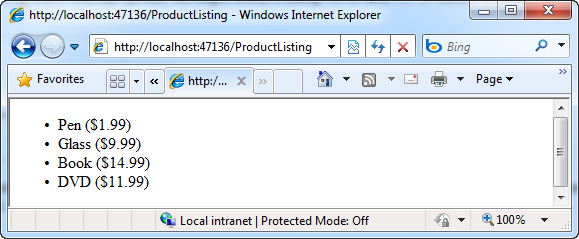
Can be generated in MVC Razor with:
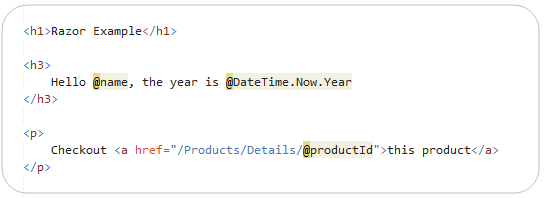
And Markdown Razor with:
# Razor Example
### Hello @name, the year is @DateTime.Now.Year
Checkout [this product](/Product/Details/@productId)
Loops and Nested HTML Sample
The simple loop example:

With MVC Razor:
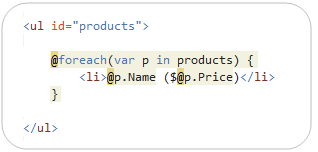
With Markdown Razor:
@foreach (var p in products) {
- @p.Name: (@p.Price)
}
Parens-Free
At this point I think it would be a good to introduce some niceties in Markdown Razor of its own. Borrowing a page out of BrendanEich proposal for CoffeeScript's inspired Parens free syntax for JS.Next - you can simply remove the parens from all block statements e.g:
@foreach var p in products {
- @p.Name: (@p.Price)
}
Produces the same output, and to go one step further you can remove the redundant var as well :)
@foreach p in products {
- @p.Name: (@p.Price)
}
Which makes the Markdown Razor's version a bit more wrist-friendly then its MVCs cousin :)
If-Blocks and Multi-line Statements
If statements in MVC Razor:
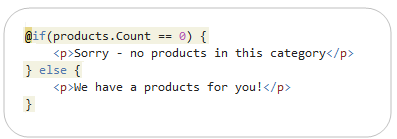
If statements in Markdown Razor:
@if (products.Count == 0) {
Sorry - no products in this category
} else {
We have products for you!
}
Multi-line and Multi-token statements
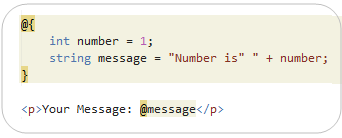
Markdown Razor doesn't support multi-line or multi-token statements, instead you are directed to take advantage for variable syntax declarations, e.g:
Markdown replacement for Multi-line Statements
@var number = 1
@var message = ""Number is "" + number
Your Message: @message
Integrating Content and Code
Does it break with email addresses and other usages of in HTML?
With MVC Razor

With Markdown Razor
Send mail to scottgu@microsoft.com telling him the time: @DateTime.Now.
Both View engines generate the expected output, e.g:

Identifying Nested Content
With MVC Razor
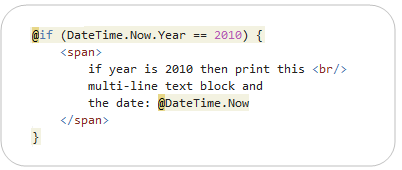
With Markdown Razor
@if (DateTime.Now.Year == 2011) {
If the year is 2011 then print this
multi-line text block and
the date: @DateTime.Now
}
Markdown Razor doesn't need to do anything special with text blocks since all it does is look for the ending brace '}'. This means if you want to output a brace literal '{' then you have to double escape it with '{{' or '}}'.
HTML Encoding
Markdown Razor follows MVC Markdown behaviour where by default content emitted using a @ block is automatically HTML encoded to better protect against XSS attack scenarios.
If you want to avoid HTML Encoding you have the same options as MVC Razor where you can wrap your result in @Html.Raw(htmlString) or if you're using an Extension method simply return a MvcHtmlString instead of a normal string.
Markdown also lets you mix and match HTML in your markdown although any markdown between the tags
does not get converted to HTML. To tell Markdown Razor to evaulate the contents inside html
<tag>...</tag>'s need to prefixed with ^, e.g.
(taken from the /Views/Search.md page):
^<div id="searchresults">
@foreach page in Model.Results {
### @page.Category > [@page.Name](@page.AbsoluteUrl)
@page.Content
}
^</div>
If we didn't prefix ^ we would see ### @page.Category ... repeating.
Layout/MasterPage Scenarios - The Basics
Markdown Razor actually deviates a bit from MVC Razor's handling of master layout pages and website templates (we believe for the better :).
Simple Layout Example
MVC Razor's example of a simple website template
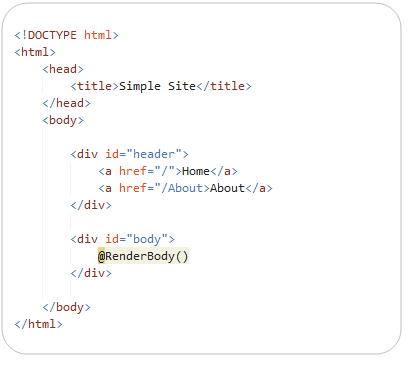
Rather then using a magic method like @RenderBody() we treat the output Body of View as just
another variable storing the output a in a variable called 'Body'. This way we use the
same mechanism to embed the body like any other variable i.e. following the place holder convention
of <--@VarName--> so to embed the View page output in the above master template you
would do:
<!DOCTYPE html>
<html>
<head>
<title>Simple Site</title>
</head>
<body>
<div id=""header"">
<a href=""/"">Home</a>
<a href=""/About"">About</a>
</div>
<div id=""body"">
<!--@Body-->
</div>
</body>
</html>
By default we use convention to select the appropriate website template for the selected view where it uses the nearest default.shtml static template it finds, looking first in the current directory than up parent directories.
Your View page names must be unique but can live anywhere in your /View directory so you are free to structure your website templates and view pages accordingly. If for whatever reason you need more granularity in selecting website templates than we provide similar options to MVC for selecting a custom template:
Select Custom Template with MVC Razor

With Markdown Razor
@Layout ~/websiteTemplate
# About this Site
This is some content that will make up the ""about""
page of our web-site. We'll use this in conjunction
with a layout template. The content you are seeing here
comes from ^^^websiteTemplate.
And obviously I can have code in here too. Here is the
current date/year: @DateTime.Now.Year
Note: In addition to @Layout we also support the more appropriate alias of @template.
Layout/MasterPage Scenarios - Adding Section Overrides
MVC Razor allows you to define sections in your view pages which you can embed in your Master Template:
With MVC Razor:
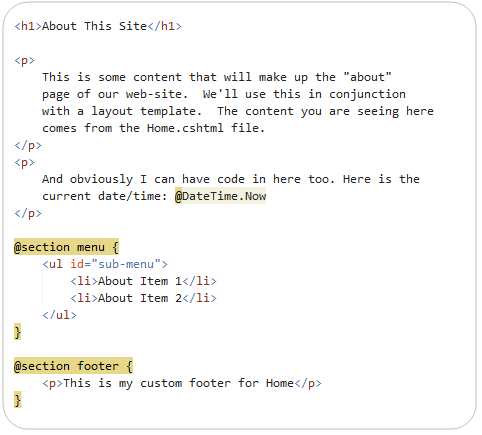
And you use in your website template like so:
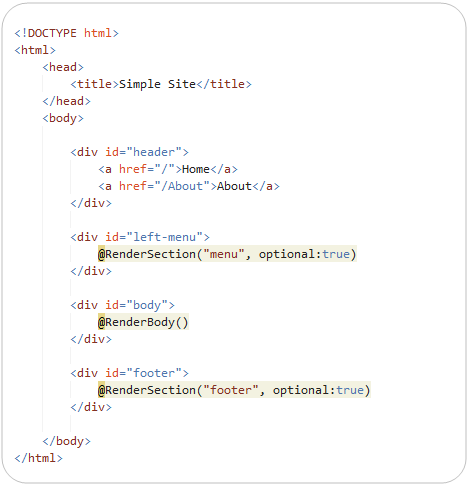
With Markdown Razor:
Markdown Razor supports the same @section construct but allows you to embed it in your template via the standard variable substitution convention, e.g:
@Layout ~/websiteTemplate
# About this Site
This is some content that will make up the ""about""
page of our web-site. We'll use this in conjunction
with a layout template. The content you are seeing here
comes from ^^^websiteTemplate.
And obviously I can have code in here too. Here is the
current date/year: @DateTime.Now.Year
@section Menu {
- About Item 1
- About Item 2
}
@section Footer {
This is my custom footer for Home
}
And these sections and body can be used in the website template like:
<!DOCTYPE html>
<html>
<head>
<title>Simple Site</title>
</head>
<body>
<div id="header">
<a href="/">Home</a>
<a href="/About">About</a>
</div>
<div id="left-menu">
<!--@Menu-->
</div>
<div id="body">
<!--@Body-->
</div>
<div id="footer">
<!--@Footer-->
</div>
</body>
</html>
Encapsulation and Re-Use with HTML Helpers
In order to encapsulate and better be able to re-use HTML Helper utils MVC Razor includes a few different ways to componentize and re-use code with HTMLHelper extension methods and declarative helpers.
Code Based HTML Helpers
HtmlHelper extension methods with MVC Razor:
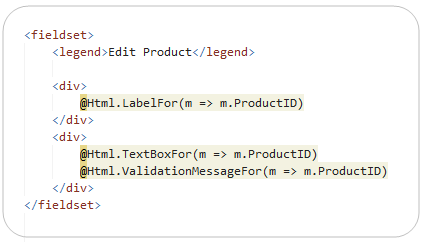
Since we've ported MVC's HtmlHelper and its Label, TextBox extensions we can do something similar although to make this work we need to inherit from the MarkdownViewBase<TModel> generic base class so we know what Model to provide the strong-typed extensions for. You can do this using the @model directive specifying the full type name:
@model ServiceStack.ServiceHost.Tests.Formats.Product
<fieldset>
<legend>Edit Product</legend>
<div>
@Html.LabelFor(m => m.ProductID)
</div>
<div>
@Html.TextBoxFor(m => m.ProductID)
</div>
</fieldset>
Whilst we ported most of MVC HtmlHelper extension methods as-is, we did rip out all the validation logic which appeared to be unnecessarily complex and too coupled with MVC's code-base.
Note: Just as it is in MVC the @model directive is a shorthand (which Markdown Razor also supports) for:
@inherits Namespace.BaseType<Namespace.ModelType>
Whilst we don't support MVC Razors quasi C# quasi-html approach of defining declarative helpers, we do allow you to on a per instance basis (or globally) import helpers in custom Fields using the @helper syntax:
@helper Prod: MyHelpers.ExternalProductHelper
<fieldset>
<legend>All Products</legend>
@Prod.ProductTable(Model)
</fieldset
You can register Global helpers and a custom base class using the MarkdownGlobalHelpers and MarkdownBaseType AppHost Config options as shown at the top of this article.
Summary
Well that's it for the comparison between MVC Razor and Markdown Razor as you can see the knowledge is quite transferable with a lot of cases the syntax is exactly the same.
As good as MVC Razor is with its wrist-friendly and expressive syntax, we believe Razor Markdown is even better! Where thanks to Markdown you can even dispense with most of HTML's boiler plage angle brackets :) We think it makes an ideal solution for content heavy websites like this one.
Unlike ASP.NET's MVC Razor, Markdown Razor like all of ServiceStack is completely Open Source and as such we welcome the contribution from the community via new features, Unit and regression tests, etc.